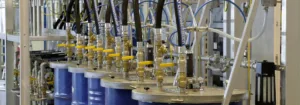Updated: September 10, 2025
The industrial world is entering a new era of innovation: hybrid motor systems that combine the strengths of air motors (pneumatic motors) and electric motors. By blending these two power sources, manufacturers and engineers can achieve higher efficiency, safety, and flexibility than ever before.
However, designing hybrid systems is not without its challenges. Successful integration requires a careful balance of control, cost, and application-specific design.
Navigating the Challenges of Hybrid Integration
1. System Complexity
Managing two power sources in one system requires sophisticated control technology. Control units must ensure seamless transitions between air and electric motors while adjusting torque, speed, and energy consumption in real time. Without this, efficiency and reliability can be compromised.
2. Cost Analysis
Although air motors themselves are cost-effective, the supporting infrastructure – compressors, storage tanks, and air distribution systems – adds investment and maintenance costs. Likewise, hybrid integration requires engineering expertise and advanced control software, which can increase upfront design expenses.
3. Application-Specific Needs
The right balance of air and electric power depends on the duty cycle, load requirements, and operating environment.
Heavy-duty robotics may use electric motors for continuous operation while relying on air motors for short bursts of high torque.
Lightweight drones may prioritize electric motors for sustained flight, with pneumatic motors offering extra thrust for rapid acceleration.
The Future is Hybrid: Emerging Technologies
Despite integration challenges, the future of hybrid motor systems looks promising. Advances in materials, control systems, and energy storage are accelerating innovation.
Advanced Battery Technology: Solid-state and lithium-sulfur batteries promise higher energy density and longer operational ranges, reducing reliance on compressed air.
Smart Control Systems: AI-driven algorithms and machine learning will optimize power delivery, predict load demands, and enable smooth transitions between motor types.
Lightweight Materials: Carbon fiber composites and advanced alloys will reduce system weight, particularly important for mobile applications such as drones, robots, and lightweight vehicles.
Why Hybrid Motor Systems Matter
By combining the continuous power of electric motors with the high torque and spark-free safety of air motors, hybrid systems deliver:
Greater energy efficiency
Improved performance flexibility
Enhanced safety in hazardous environments
Opportunities for sustainable innovation in manufacturing, automation, robotics, and transportation
The world of motors is evolving rapidly. Hybrid systems are no longer just a concept – they represent the next step in achieving sustainable, adaptable, and high-performance solutions for industries worldwide.
The Synergistic Power of Air and Electric Motors FAQ
A hybrid motor system combines air (pneumatic) motors and electric motors to optimize performance, safety, and efficiency.
Air motors provide spark-free safety and high torque at startup, while electric motors deliver efficiency for continuous operation. Together, they offer a balanced solution.
Robotics, aerospace, drones, automotive, and industrial machinery are key industries leveraging hybrid motor solutions.
While upfront costs can be higher due to compressors and control systems, the long-term benefits—efficiency, flexibility, and safety—often outweigh initial investment.
Smart AI control systems, high-density batteries, and lightweight materials are expected to drive the next generation of hybrid integration.


